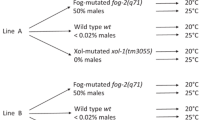Summary
Free-living nematodes are endowed with a set of properties that make them specially attractive for experimental work. Geneticists and evolutionists may be especially interested in their easy cultivation, great fecundity and polymorphism. As an example, some results are brought concerningCaenorhabditis elegans and related species: (1) Sex determination occurs as the expression of a genic balance involving differences in the number of chromosomes. The alternatives gynogenesis, amphimixis, or auto-heterofecundation take a prominent place in the reproductive processes of these species. (2) Polyploidy may be obtained by heat-shock, giving rise to individuals showing characteristic chromosomal unbalance and variability. (3)C. elegans, which cannot normally be raised at a higher temperature than 22°C, has been gradually adapted to temperatures up to 24.5°C. This acclimatization implies an adaptive transformation of the ovarian physiology; this effect is obtained after long training, taking more than 1000 generations. Study of the process of acclimatization shows that its genetical basis may be partly of a non-genic nature, partly of a genic type. Hypotheses are developed for explaining this phenomenon and for the understanding of the evolution from free-living to parasitic nematodes.
Similar content being viewed by others
Literatur
W. L. Nicholas, E. C. Dougherty etE. L. Hansen, Ann. N.Y. Acad. Sci.77, 218 (1959).
E. L. Hansen, E. A. Yarwood, W. L. Nicholas etF. W. Sayre, Nematologica5, 27 (1960).
V. Nigon etE. C. Dougherty, J. Hered.41, 103 (1950).
H. Hirschmann, Zool. Jb. (Systemat.)40, 132 (1951).
A. Wessing, Z. Zellforsch. mikrosk. Anat.44, 101 (1956).
J. Brun, Annls Biol. anim. Biochim. Biophys.6, 127, 267 et 439 (1966).
H. V. Fatt etE. C. Dougherty, Science, N.Y.140, 266 (1963).
V. Nigon, Annals Sci. nat. (Zool.)11, 1 (1949).
E. Maupas, Archs Zool. exp. gén.8, 463 (1900).
V. Nigon, C. r. Séanc. Soc. Biol.137, 40 (1943).
V. Nigon etJ. Brun, Chromosoma7, 129 (1955).
V. Nigon, P. Guerrier etH. Monin, Bull. biol. Fr. Belg.93, 131 (1960).
R. Delavault, Archs Zool. exp. gén.97, 109 (1959).
V. Nigon, Bull. biol. Fr. Belg.85, 187 (1951).
V. Nigon, C. r. hebd. Séanc. Acad. Sci., Paris234, 2568 (1952).
P. Hertwig, Arch. mikrosk. Anat. EntwMech.94, 303 (1920).
J. Brun, Science, N.Y.150, 1467 (1965).
A. I. Lansing, Ann. N.Y. Acad. Sci.57, 455 (1954).
G. Osche, Zool. Jb. (Systemat.)82, 618 (1954).
P. P. Grassé,Traité de Zoologie IV, 2 et 3:Némathelminthes (Masson, Paris 1965).
V. Nigon etE. Roman, Bull. biol. Fr. Belg.86, 404 (1952).
Author information
Authors and Affiliations
Rights and permissions
About this article
Cite this article
Nigon, V., Brun, J. Génétique et évolution des Nématodes libres. Perspectives tirées de l'étude deCaenorhabditis elegans. Experientia 23, 161–170 (1967). https://doi.org/10.1007/BF02136263
Published:
Issue Date:
DOI: https://doi.org/10.1007/BF02136263




